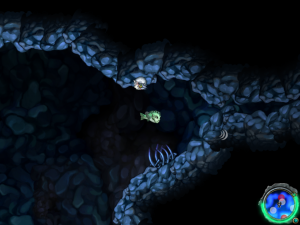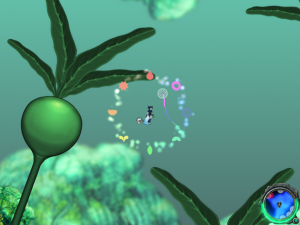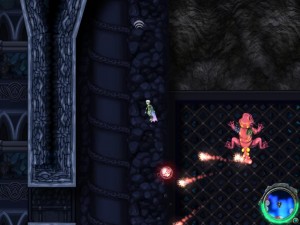It’s been a while since I bought a new A-list title. I tend to wait for the major heavily-advertised games to be remaindered or even bundled when I have any interest in them at all, which is seldom the case these days: recent blockbusters seem to all be military-themed FPSes. When I hear people around the office talking about such things, it leaves me cold. Hearing them tiptoe around spoilers for Portal 2, on the other hand, just piqued my curiosity. For Portal 2 is a rare thing: a major heavily-advertised puzzle game. I don’t think I’ve seen a puzzle game advertised on bus hoardings since the first Professor Layton. And so, after resolutely ignoring the potato-themed ARG, I finally knuckled under and bought the thing last friday, played through the entire single-player story on Saturday, and on Sunday, instead of writing up the experience, got drawn into playing the two-player co-op mode, again completing it in a single marathon session. (So I’m posting this about a week late. Chalk it up to the difficulty of summarizing the total experience of something so recently well-covered elsewhere.)
Before I start talking plot, I have some general non-spoilery observations. Portal 2 is longer than its predecessor, more detailed, and wackier. Portal wasn’t particularly wacky. It had humor, but the humor was dry, and furthermore, superficial — by which I mean, one could imagine making an alternate version of Portal that plays it completely straight without altering the plot or gameplay at all. (Not that I’d recommend doing so. Much of the game’s charm is in its piquant blend of absurdity and living nightmare.) Portal 2, on the other hand, is more of a tall tale. It makes the ridiculous central to the plot, to the point where it starts to seem strange that this is set in the same universe as Half-Life. It puts me in mind of comic-book continuities, how John Constantine shares a world with the likes of Lobo and Ambush Bug. It seems to me that this shift of emphasis is risky. A light dusting of wit can enhance any game, but in scenes where comedy is the main focus, the game is only as good as it is funny. (I’ve cited MDK2 before as an example of how this can go wrong.) Fortunately, Valve got some pretty good voice-acting talent. I don’t know how much of Stephen Merchant’s lines were ad-libbed, but he has a way of making them sound ad-libbed even when they aren’t.
The puzzle content follows a typical pattern for puzzle games, steadily introducing new elements and exploring how they interact with what’s already been seen. (It’s what I think of as the DROD model.) The original Portal kind of did the same thing, introducing turrets and high-energy pellets one by one, and even doling out the portal gun in pieces, but that all seemed much more basic, like they could have introduced everything at once if they wanted to and they were spacing stuff out purely for the sake of spacing it out. The portal gun itself was the only real puzzle-enabling device, and everything else was just an environmental feature that provided material for portal-puzzles. Portal 2 often feels like it’s the other way around: that the portal gun is just a tool for executing gel-puzzles, laser-puzzles, etc. Crucially, some of the new elements are new means of transporting things or altering their trajectories: excursion funnels, light bridges, even repulsion gel at times, which can be both a means of transportation and a thing that needs to be transported. The original Portal had only one novel way to move objects around at a distance, and thus mainly focused on getting the player character around. A lot of the puzzles in Portal 2 involve moving objects around by novel means while you’re stuck standing on a button or something. In the co-op levels, the thing you’re transporting is often the other player, but the same principles apply.
Now to be more specific, and hence more spoilery. The game has three distinct runs of “test chambers”, bracketed and to some extent interrupted by behind-the-scenes stuff. The way that the game begins behind the scenes is a pretty big change from the enigmatic opening of the original. There, getting access to the areas outside the enumerated puzzle-game structure was the big twist, but here, it’s just part of the routine. (It reminds me just a little of Unreal, which is mainly structured around a series of building interiors punctuated by brief forays outdoors to get to the next building.) And once you have a routine, there’s a need to break it up with variety, even if it’s fake variety. Thus, reskinning! The middle run of test chambers is set in a long-forgotten section of Aperture Laboratories, implausibly deep below the surface, where we see what mad science testing environments were like in the 1940s and 1970s. This section is to the labs above what Red Alert is to Command & Conquer, replacing the gleaming engineered-looking Weighted Storage Cubes with simple wooden boxes, the glowing indicators with clack boards, and in general the futuristic high tech with precisely equivalent low — for example, the Aperture Science Unstationary Platform from the original, a levitating device that moved back and forth on some sort of energy beam, is replaced by something like a window-washer’s platform hanging from the ceiling by ropes. The very existence of low-tech equivalents underscores the tremendous wastefulness and impracticality of the whole operation. Company founder Cave Johnson, we learn, was in the habit of insisting on his own way against all sane advice, flew into rages at the least provocation (or sometimes none at all), and had enough power within the company that any half-baked idea he blurted out on a whim would be implemented at enormous expense. Even now that he’s gone, his legacy of preferring the complicated and inefficient remains.
Relics of Aperture’s past, along with recorded messages from Cave at various points in the company’s history, tell the story of its fall. Appropriately, this section of the game is precipitated by a literal fall down a shaft on the player’s part. The upper labs, on the other hand, starts off in a fallen state, decayed and overgrown, and it’s a rise up a different shaft, lined with electrical switches that are turned on by your passage, that triggers GLaDOS’s rise from the dead, followed by the gradual restoration of the facility to pristine condition.
GLaDOS herself is in much better condition than before her death, free from the audio glitches and lacunae found in the first game. Presumably such things were the result of the ethical constraint core that you destroyed at the end of the first game, or rather, of the self-sabotage GLaDOS engaged in to work around it. (Similarly, the dropping of the cake meme can be attributed to the destruction of her cake core.) She comes off as smarter, too, anthropomorphizing plainly inanimate things less and wasting no time on pathetically transparent attempts at deception. I suppose that’s because the time for that is over now that you’re openly enemies, but on a higher level, it’s because the role of humorously incompetent AI has been taken over by Wheatley, your sometime helper before the fall.
Of course, that’s not all Wheatley takes over. Wheatley’s conquest of the Enrichment Center — of Glados’s body, even — is the first moment that a male voice is in control, and things immediately take a turn for the worse — this is the point when both of the game’s strong female characters are literally cast down. For a while, Cave Johnson’s pre-recorded messages take over as antagonist, providing another male voice, but Johnson, as someone confident in his authority, is more of a bad father figure to match GLaDOS’s bad mother, while Wheatley is more like a spoiled kid with too much power. A spoiled pubescent kid, yet: the facility’s systems automatically give him a nagging urge to put humans through test chambers and a jolt of pleasure whenever you solve a puzzle, causing him to moan orgasmically. (I don’t think it’s a coincidence that this section immediately follows the discovery of tubes that spew viscous fluids, either.) This changes the tone of the exercise somewhat: GLaDOS hated you and wanted to murder you, but Wheatley effectively wants to rape you. The one thing that keeps this from being too horrible is that he’s so bad at it.
 My last session netted me two more songs for transforming — apparently this is what most of the songs do. First off was fish form, which turns you into a small fish with an oddly human face.
My last session netted me two more songs for transforming — apparently this is what most of the songs do. First off was fish form, which turns you into a small fish with an oddly human face. Comments(0)
Comments(0)
